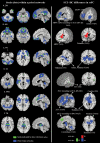Dysfunction of Large-Scale Brain Networks in Schizophrenia: A Meta-analysis of Resting-State Functional Connectivity
- PMID: 28338943
- PMCID: PMC5767956
- DOI: 10.1093/schbul/sbx034
Dysfunction of Large-Scale Brain Networks in Schizophrenia: A Meta-analysis of Resting-State Functional Connectivity
Abstract
Schizophrenia is a complex mental disorder with disorganized communication among large-scale brain networks, as demonstrated by impaired resting-state functional connectivity (rsFC). Individual rsFC studies, however, vary greatly in their methods and findings. We searched for consistent patterns of network dysfunction in schizophrenia by using a coordinate-based meta-analysis. Fifty-six seed-based voxel-wise rsFC datasets from 52 publications (2115 patients and 2297 healthy controls) were included in this meta-analysis. Then, coordinates of seed regions of interest (ROI) and between-group effects were extracted and coded. Seed ROIs were categorized into seed networks by their location within an a priori template. Multilevel kernel density analysis was used to identify brain networks in which schizophrenia was linked to hyper-connectivity or hypo-connectivity with each a priori network. Our results showed that schizophrenia was characterized by hypo-connectivity within the default network (DN, self-related thought), affective network (AN, emotion processing), ventral attention network (VAN, processing of salience), thalamus network (TN, gating information) and somatosensory network (SS, involved in sensory and auditory perception). Additionally, hypo-connectivity between the VAN and TN, VAN and DN, VAN and frontoparietal network (FN, external goal-directed regulation), FN and TN, and FN and DN were found in schizophrenia. Finally, the only instance of hyper-connectivity in schizophrenia was observed between the AN and VAN. Our meta-analysis motivates an empirical foundation for a disconnected large-scale brain networks model of schizophrenia in which the salience processing network (VAN) plays the core role, and its imbalanced communication with other functional networks may underlie the core difficulty of patients to differentiate self-representation (inner world) and environmental salience processing (outside world).
Keywords: brain networks; disconnected model; meta-analysis; resting-state; salience network; schizophrenia.
© The Author(s) 2017. Published by Oxford University Press on behalf of the Maryland Psychiatric Research Center. All rights reserved. For permissions, please email: journals.permissions@oup.com.
Figures


References
-
- Whiteford HA, Degenhardt L, Rehm J, et al. Global burden of disease attributable to mental and substance use disorders: findings from the Global Burden of Disease Study 2010. Lancet. 2013;382:1575–1586. - PubMed
-
- Fitzsimmons J, Kubicki M, Shenton ME. Review of functional and anatomical brain connectivity findings in schizophrenia. Curr Opin Psychiatry. 2013;26:172–187. - PubMed
-
- Fornito A, Zalesky A, Pantelis C, Bullmore ET. Schizophrenia, neuroimaging and connectomics. Neuroimage. 2012;62:2296–2314. - PubMed
Publication types
MeSH terms
LinkOut - more resources
Full Text Sources
Other Literature Sources
Medical
Miscellaneous

